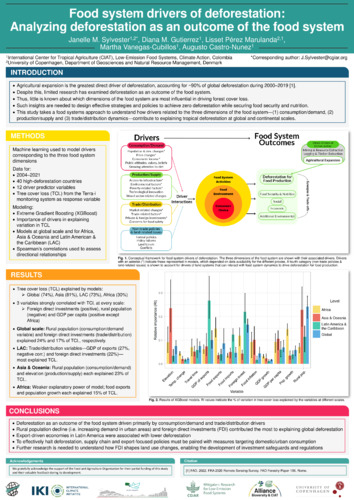Food system drivers of deforestation: Analyzing deforestation as an outcome of the food system
According to the latest Global Forest Resources Assessment, approximately 90% of global deforestation between 2000 and 2018 was attributable to agricultural expansion, positioning land use for food production as the greatest direct driver of deforestation. Studies investigating direct and underlying drivers of deforestation have generally employed a land systems approach, focusing on how interactions between human and environment systems influence land use and land cover change. Yet, despite the significant role of agricultural expansion in driving deforestation, limited research has explored deforestation through the lens of the food system. Consequentially, our understanding of the food system dynamics that drive deforestation for food production remains limited. In response to this research gap, this study proposes and operationalizes a novel framework for the study of food system drivers of deforestation. We use a critical analysis of frameworks and a systematic literature review of underlying drivers of deforestation to develop the framework and machine learning techniques (Extreme Gradient Boosting) to apply the framework at the global and continental scale to determine how drivers related to the three dimensions of the food system – (1) consumption/demand, (2) production/supply, and (3) trade/distribution – are influencing forest cover changes. The results indicate that demand- and trade-side dynamics are playing significant roles in driving deforestation at the global, Asia and Latin America scales, and that foreign direct investments (FDI), in particular, explained a large proportion of deforestation. This suggests that food system-based interventions could be effective in reducing deforestation in these regions and that greater attention should be given to the role of FDI in forest cover changes. Analyzing deforestation as an outcome of the food system can provide critical insights into where interventions within the food system are needed to reduce deforestation and how such interventions can be aligned with improving food security and nutrition as well as other sustainable development goals.

